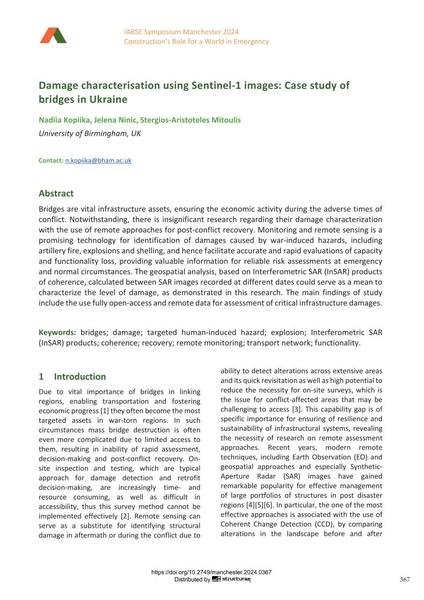Damage characterisation using Sentinel-1 images: Case study of bridges in Ukraine

|
|
|||||||||||
Détails bibliographiques
| Auteur(s): |
Nadiia Kopiika
(University of Birmingham, UK)
Jelena Ninić (University of Birmingham, UK) Stergios-Aristoteles Mitoulis (University of Birmingham, UK) |
||||
|---|---|---|---|---|---|
| Médium: | papier de conférence | ||||
| Langue(s): | anglais | ||||
| Conférence: | IABSE Symposium: Construction’s Role for a World in Emergency, Manchester, United Kingdom, 10-14 April 2024 | ||||
| Publié dans: | IABSE Symposium Manchester 2024 | ||||
|
|||||
| Page(s): | 367-375 | ||||
| Nombre total de pages (du PDF): | 9 | ||||
| DOI: | 10.2749/manchester.2024.0367 | ||||
| Abstrait: |
Bridges are vital infrastructure assets, ensuring the economic activity during the adverse times of conflict. Notwithstanding, there is insignificant research regarding their damage characterization with the use of remote approaches for post-conflict recovery. Monitoring and remote sensing is a promising technology for identification of damages caused by war-induced hazards, including artillery fire, explosions and shelling, and hence facilitate accurate and rapid evaluations of capacity and functionality loss, providing valuable information for reliable risk assessments at emergency and normal circumstances. The geospatial analysis, based on Interferometric SAR (InSAR) products of coherence, calculated between SAR images recorded at different dates could serve as a mean to characterize the level of damage, as demonstrated in this research. The main findings of study include the use fully open-access and remote data for assessment of critical infrastructure damages. |
||||
| Mots-clé: |
ponts
|
||||
